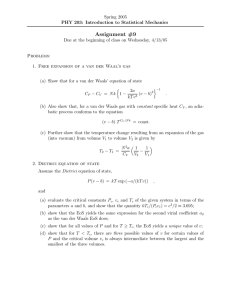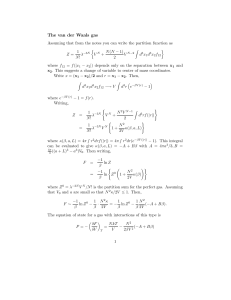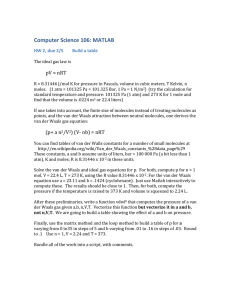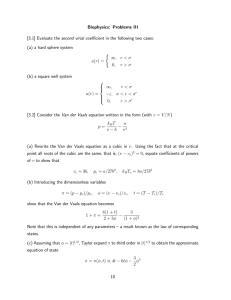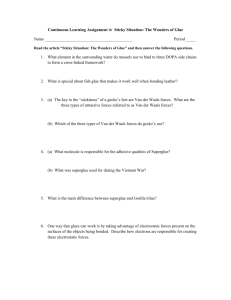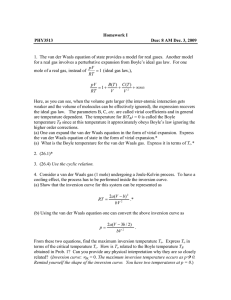V.C The Second Virial Coefficient ...
advertisement
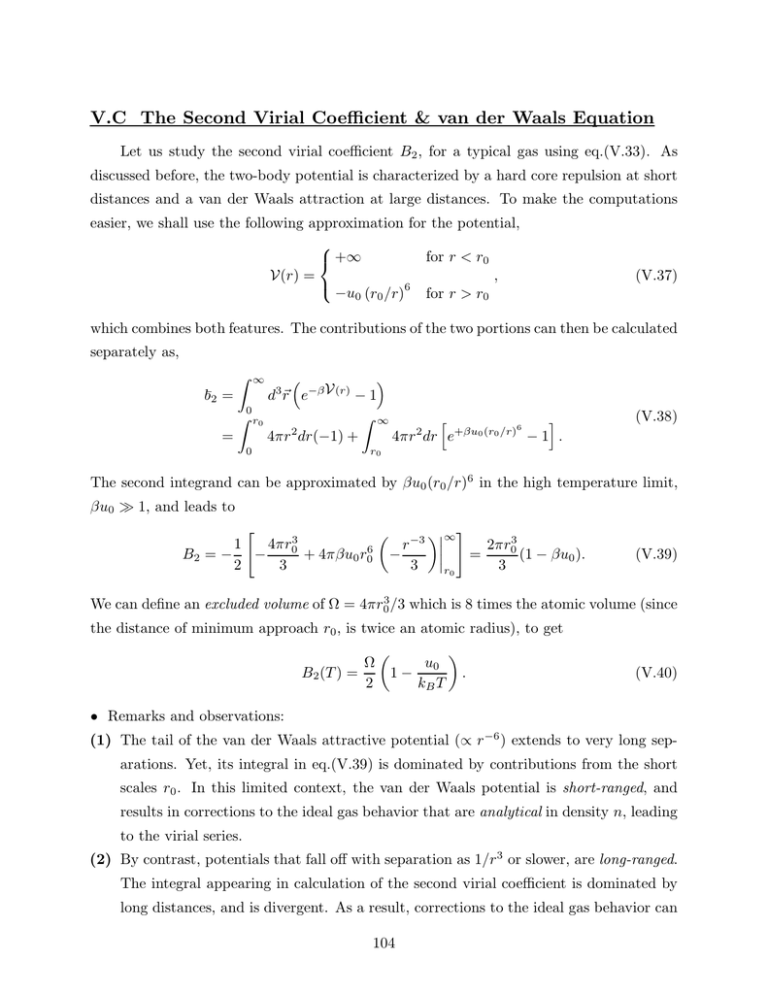
V.C The Second Virial Coefficient & van der Waals Equation
Let us study the second virial coefficient B2 , for a typical gas using eq.(V.33). As
discussed before, the two-body potential is characterized by a hard core repulsion at short
distances and a van der Waals attraction at large distances. To make the computations
easier, we shall use the following approximation for the potential,
for r < r0
+∞
V(r) =
,
6
−u0 (r0 /r) for r > r0
(V.37)
which combines both features. The contributions of the two portions can then be calculated
separately as,
Z
∞
d3~r e−β V (r) − 1
Z0
r0
Z ∞
h
i
6
2
4πr 2 dr e+βu0 (r0 /r) − 1 .
=
4πr dr(−1) +
b̄2 =
0
(V.38)
r0
The second integrand can be approximated by βu0 (r0 /r)6 in the high temperature limit,
βu0 ≫ 1, and leads to
"
−3 ∞ #
1
4πr03
2πr03
r
+ 4πβu0 r06 −
=
(1 − βu0 ).
B2 = − −
2
3
3 r0
3
(V.39)
We can define an excluded volume of Ω = 4πr03 /3 which is 8 times the atomic volume (since
the distance of minimum approach r0 , is twice an atomic radius), to get
Ω
B2 (T ) =
2
u0
1−
.
kB T
(V.40)
• Remarks and observations:
(1) The tail of the van der Waals attractive potential (∝ r −6 ) extends to very long sep­
arations. Yet, its integral in eq.(V.39) is dominated by contributions from the short
scales r0 . In this limited context, the van der Waals potential is short-ranged, and
results in corrections to the ideal gas behavior that are analytical in density n, leading
to the virial series.
(2) By contrast, potentials that fall off with separation as 1/r 3 or slower, are long-ranged.
The integral appearing in calculation of the second virial coefficient is dominated by
long distances, and is divergent. As a result, corrections to the ideal gas behavior can
104
not be written in the form of a virial series, and are in fact non-analytic. A good
example is provided by the Coulomb interactions (see problems for the test), where
the non-analytic corrections can be obtained by summing all the ring diagrams in the
cumulant (or cluster) expansions.
(3) The second virial coefficient has dimensions of volume, and (for short-range potentials)
is proportional to the atomic volume Ω. In the high temperature limit, the importance
of corrections to ideal gas behavior can be estimated by comparing the first two terms
of eq.(V.14),
B2
Atomic volume
gas density
B 2 n2
= −1 ∼
∼
.
n
n
volume per particle in gas
liquid density
(V.41)
This ratio is roughly 10−3 for air at room temperature and pressure. The corrections
to ideal gas behavior are thus small at low densities. On dimensional grounds, a similar
ratio is expected for the higher order terms, Bℓ nℓ /Bℓ−1 nℓ−1 , in the virial series. We
may thus suspect the convergence of the series at high enough densities (when the gas
liquifies).
(4) The virial expansion breaks down not only at high densities, but also at low temper­
atures. This is suggested by the divergences in eqs.(V.40) and (V.38) as T → 0, and
reflects the fact that in the presence of attractive interactions the particles can lower
their energy at low temperatures by condensing into a liquid state.
(5) The truncated virial expansion,
P
Ω
=n+
2
kB T
u0
1−
kB T
n2 + · · · ,
can be rearranged as
1
u0 Ω 2
Ω
n
N
=
.
n = n 1+n +··· ≈
P+
2
2
1 − nΩ/2
V − N Ω/2
kB T
This is precisely in the form of the van der Waals equation
"
2 # NΩ
u0 Ω N
P+
V −
= N kB T,
2
V
2
(V.42)
(V.43)
(V.44)
and we can identify the van der Waals parameters, a = u0 Ω/2 and b = Ω/2.
• Physical interpretation of the van der Waals equation: Historically, van der Waals
suggested eq.(V.44) on the basis of experimental results for the equation of state of various
105
gases, towards the end of the19th century. At that time the microscopic interactions
between gas particles were not known, and van der Waals postulated the necessity of an
attractive interaction between gas atoms based on the observed decreases in pressure. It
was only later on that such interactions were observed directly, and then attributed to the
induced dipole–dipole forces by London. The physical justification of the correction terms
is as follows.
(a) There is a correction to the gas volume V due to the hard core exclusions. At first sight,
it may appear surprising that the excluded volume b, in eq.(V.44) is one half of the volume
that is excluded around each particle. This is because this factor measures a joint excluded
volume involving all particles in phase space. In fact, the contribution of coordinates to
the partition function of the hard-core gas can be estimated at low densities, from
SN =
Z
′
Q
3
qi
1
1
id ~
=
V V − Ω V − 2Ω · · · V − (N − 1)Ω ≈
N!
N!
N!
N
NΩ
V −
.
2
(V.45)
The above result is obtained by adding particles one at a time, and noting that the available
volume for the mth particle is (V − mΩ). At low densities, the overall effect is a reduction
of the volume available to each particle by approximately Ω/2. Of course, the above result
is only approximate, since the effects of excluded volume involving more than two particles
are not correctly taken into account. The relatively simple form of eq.(V.45) is only exact
at for spatial dimensions d = 1 and infinity. As proved in problems for the test, the exact
excluded volume in d = 1 is in fact Ω.
(b) The decrease in pressure P , due to attractive interactions, is somewhat harder to
quantify. In sec.III.F, the gas pressure was related to the impacts of particles on a wall via
= nmvx2 ,
(V.46)
P = (nvx )(2mvx )
vx <0
where the first term is the number of collisions per unit time and area, while the second is
the momentum imparted by each particle. For the ideal gas, the usual equation of state
is recovered by noting that the average kinetic energy is mvx2 /2 = kB T /2. Attractive
interactions lead to a reduction in pressure given by
δP = δn mvx2 + nδ mvx2 .
(V.47)
While different statistical ensembles give the same pressure, which is a bulk state function,
they may lead to different behaviors at the surface. We must thus be careful, and consistent,
in evaluation of eq.(V.47), which depends of surface properties.
106
In a canonical ensemble, the gas density is reduced at the walls. This is because the
particles in the middle of the box experience an attractive potential V from all sides, while
at the edge only an attractive energy of V /2 is available from half of the space. The
resulting change in density is approximately
δn ≈ n e−βV /2 − e−βV ≈ βnV /2.
(V.48)
Integrating the interaction of one particle in the bulk with the rest gives
V =
Z
d3 ~r V attr. (r) n = −nΩu0 .
(V.49)
The change in density thus gives the pressure correction of δP = −n2 Ωu0 /2 calculated
in eq.(V.44). There is no correction to the kinetic energy of the particles impinging on
the wall, since in the canonical formulation the probabilites for momentum and location
of the particles are independent variables. The probability distribution for momentum is
uniform in space, giving the average kinetic energy of kB T /2 for each direction of motion.
A different explanation is presented in a kinetic formulation in which particles follow
the deterministic Hamiltonian equations of motion. In this formulation, the impinging
particles lose kinetic energy in approaching the wall from the surface, since they have to
climb out of the potential well set up by the attractions of bulk particles. The reduction
in kinetic energy is given by
1
mvx2
=
δ
2
2
Z
1
d3 ~r V attr. (r) n = − nΩu0 .
2
(V.50)
The reduced velocities lead to an increase in the surface density in this case, as the slower
particles spend a longer time τ in the vicinity of the wall! The relative change in density
is given by
δvx
1 δvx2
δn
δτ
=
=−
=−
,
n
τ
vx
2 vx2
=⇒
δn = −βnV /2.
(V.51)
The increase in density is precisely the opposite of the result of eq.(V.48) in the canonical
formulation. However, with the decrease in kinetic energy calculated in eq.(V.50), it again
leads to the correct reduction in pressure.
107
V.D Breakdown of the van der Waals equation
As discussed in sec.I.I, mechanical stability of a gas requires the positivity of the
isothermal compressibility, κT = −V −1 ∂V /∂P |T . This condition can be obtained by
examining density fluctuations in a grand canonical ensemble. The probability of finding
N particles in a volume V is given by eq.(IV.102) as
p(N, V ) =
eβµN Z(T, N, V )
.
Q
(V.52)
Since for a gas ln Q = −βG = P V /kB T , eqs.(IV.103) and (IV.104) simplify to
∂(ln Q)
∂P
�N �c = N = ∂(βµ) = V ∂µ
,
T,V
2
∂ (ln Q)
∂N ∂�N �c
2
= kB T
.
=
�N �c =
∂(βµ)
∂µ
∂(βµ)2
(V.53)
T,V
Dividing the two equations, and using the chain rule, results in
�N 2 �c
kB T ∂N kB T ∂N ∂V
=
−
=
nkB T κT .
=
N
V ∂V
P,T ∂P
N,T
V ∂P T,V
(V.54)
The positivity of κT is thus tied to that of the variance of N . A stable value of N
corresponds to a maximum of the probability p(N, V ), i.e. a positive compressibility. A
negative κT actually corresponds to a minimum in p(N, V ) implying that the system is least
likely to be found at such densities. Fluctuations in density will then occur spontaneously
and change the density to a stable value.
Any approximate equation of state, such as the van der Waals equation, must at
least satisfy the stability requirements. However, the van der Waals isotherms contain a
portion with − ∂P/∂V |T < 0, for temperatures less than a critical value Tc . The negative
compressibility implies an instability towards forming domains of lower and higher density,
i.e. phase separation. The attractive interactions in real gases do indeed result in a liquid–
gas phase separation at low temperatures. The isotherms then include a flat portion,
∂P/∂V |T = 0, at the coexistence of the two phases. Can the (unstable) van der Waals
isotherms be used to construct the phase diagram of a real gas?
One way of doing so is by the following Maxwell construction: The variations of the
chemical potential µ(T, P ), along an isotherm are obtained by integrating eq.(V.53), as
V
dµ = dP,
N
=⇒
µ(T, P ) = µ(T, PA ) +
Z
P
PA
108
dP ′
V (T, P ′ )
.
N
(V.55)
Since the van der Waals isotherms for T < Tc are non-monotonic, there is a range of
pressures that correspond to three different values, {µα }, of the chemical potential. The
possibility of several values of µ at a given temperature and pressure indicates phase
coexistence. In equilibrium, the number of particles in each phase Nα , adjusts so as
P
to minimize the Gibbs free energy G =
α µα Nα . Clearly, the phase with lowest µα
will acquire all the particles. A phase transition occurs when two branches of allowed
chemical potentials intersect. From eq.(V.55), the critical pressure Pc , for this intersection
is obtained from the condition
I
Pc
dP ′ V (T, P ′ ) = 0.
(V.56)
Pc
A geometrical interpretation of the above result is that Pc corresponds to a pressure that
encloses equal areas of the non-monotonic isotherm on each side. The Maxwell construction
approach to phase condensation is somewhat unsatisfactory, as it relies on integrating a
clearly unphysical portion the van der Waals isotherm. A better approach that makes the
approximations involved more apparent is presented in the next section.
V.E Mean Field Theory of Condensation
In principle, all properties of the interacting system, including phase separation,
are contained within the thermodynamic potentials that can be obtained by evaluating
Z(T, N ) or Q(T, µ). Phase transitions, however, are characterized by discontinuities in
various state functions and must correspond to the appearance of singularities in the par­
tition functions. At first glance, it is somewhat surprising that any singular behavior
should emerge from computing such well behaved integrals (for short-ranged interactions)
as
Z(T, N, V ) =
Z QN
3
3
d p~i d ~qi
exp −β
N !h3N
i=1
N
X
i=1
p2i
2m
−β
X
i<j
V(q~i − ~qj ) .
(V.57)
Instead of evaluating the integrals perturbatively, we shall now set up a reasonable ap­
proximation scheme. The contributions of the hard core and attractive portions of the
potential are again treated separately, and the partition function approximated by
Z(T, N, V ) ≈
1 1
V V − Ω · · · V − (N − 1)Ω exp(−βŪ ).
3N
N! λ
|
{z
}
Excluded volume effects
109
(V.58)
Here Ū represents an average attraction energy, obtained by assuming a uniform density
n = N/V , as
Z
X
1
1
¯=
U
V attr. (q~i − ~qj ) =
d3~r1 d3~r2 n(~r1 )n(~r2 )V attr. (~r1 − ~r2 )
2 i,j
2
Z
n2
N 2
≈ V
d3~r V attr. (~r ) ≡ −
u.
2
2V
(V.59)
The parameter u describes the net effect of the attractive interactions. Substituting into
eq.(V.58) leads to the following approximation for the partition function
βuN 2
(V − N Ω/2)N
Z(T, N, V ) ≈
exp
.
2V
N !λ3N
(V.60)
From the resulting free energy,
F = −kB T ln Z = −N kB T ln(V − N Ω/2) + N kB T ln(N/e) + 3N kB T ln λ −
we obtain the expression for the pressure in the canonical ensemble as
∂F uN 2
N kB T
Pcan = −
=
−
.
2V 2
∂V T,N
V − N Ω/2
uN 2
, (V.61)
2V
(V.62)
Remarkably, the uniform density approximation reproduces the van der Waals equa­
tion of state. However, the self-consistency of this approximation can now be checked.
As long as κT is positive, eq.(V.54) implies that the variance of density vanishes for large
volumes as n2 c = kB T n2 κT /V . But κT diverges at Tc , and at lower temperatures its
negativity implies an instability towards density fluctuations as discussed in the previous
section. When condensation occurs, there is phase separation into high (liquid) and low
(gas) density states, and the uniform density assumption becomes manifestly incorrect.
This difficulty is circumvented in the grand canonical ensemble. Once the chemical poten­
tial is fixed, the number of particles (and hence density) in this ensemble is automatically
adjusted to that of the appropriate phase.
As the assumption of a uniform density is correct for both the liquid and gas phases,
we can use the approximations of eqs.(V.59) and (V.60) to estimate the grand partition
function
Q(T, µ, V ) =
∞
X
N=0
βµN
e
Z(T, N, V ) ≈
∞
X
N=0
V
Ω
βuN 2
exp N ln
−
+
+ ΔN , (V.63)
N
2
2V
110
where Δ = 1 + βµ − ln(λ3 ). As in any sum over exponentials in N , the above expression
is dominated by a particular value of particle number (hence density), and given by
V
Ω
βuN 2
Q(T, µ, V ) ≈ exp max N Δ + N ln
−
+
.
N
2
2V N
(V.64)
Hence, the grand canonical expression for the gas pressure is obtained from
βPg.c =
ln Q
= max[Ψ(n)]n ,
V
where
Ψ(n) = nΔ + n ln n
−1
Ω
−
2
+
(V.65)
βu 2
n .
2
(V.66)
The possible values of density are obtained from dΨ/dn|nα = 0, and satisfy
Δ = − ln
Ω
−
2
n−1
α
+
1
− βunα .
1 − nα Ω/2
(V.67)
The above equation in fact admits multiple solutions nα for the density. Substituting the
resulting Δ into eq.(V.65) leads after some manipulation to
Pg.c.
u
n α kB T
= max
− n2α
1 − nα Ω/2 2
= max[Pcan (nα )]α ,
(V.68)
α
i.e. the grand canonical and canonical values of pressure are identical at a particular
density. However, if eq.(V.67) admits multiple solutions for the density at a particular
chemical potential, the correct density is uniquely determined as the one that maximizes
the canonical expression for pressure (or for ψ(n)).
The mechanism for the liquid–gas phase transition is therefore the following. The
sum in eq.(V.63) is dominated by two large terms at the liquid and gas densities. At
a particular chemical potential, the stable phase is determined by the larger of the two
terms. The phase transition occurs when the dominant term changes upon varying the
temperature. In mathematical form
βV Pliquid
ln Q = lim ln e
V →∞
βV Pgas
+e
=
βV Pgas
βV Pliquid
for T > T ∗
.
for T < T
(V.69)
∗
The origin of the singularity in density can thus be traced to the thermodynamic limit of
V → ∞. There are no phase transitions in finite systems!
111
MIT OpenCourseWare
http://ocw.mit.edu
8.333 Statistical Mechanics I: Statistical Mechanics of Particles
Fall 2013
For information about citing these materials or our Terms of Use, visit: http://ocw.mit.edu/terms.
